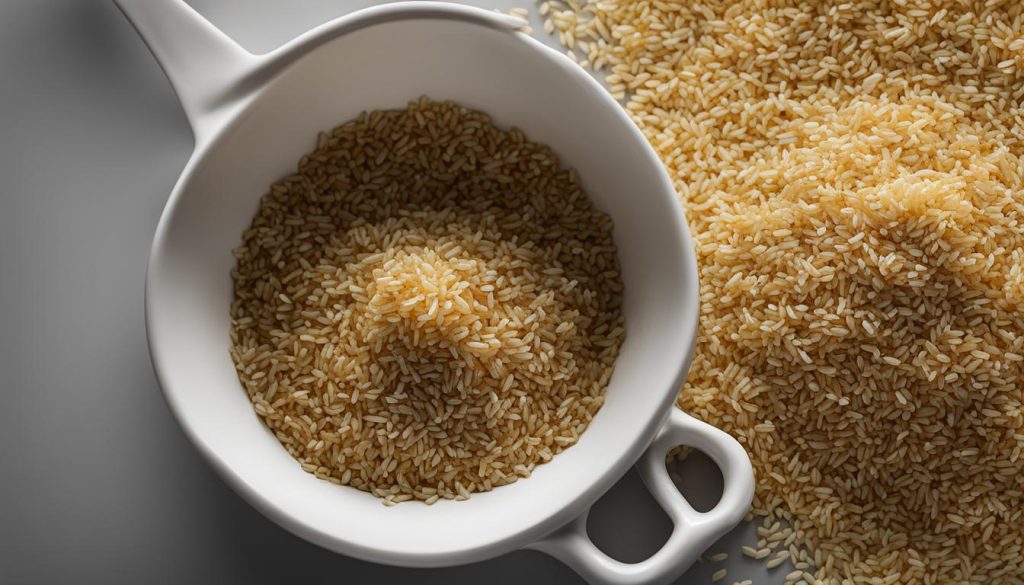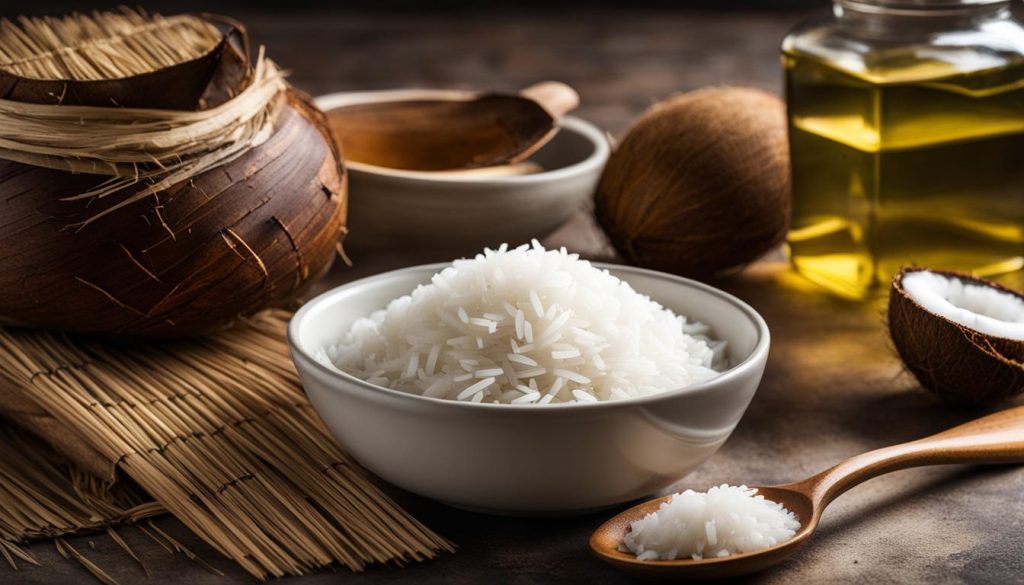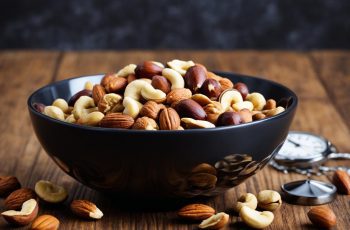Greetings! I’m here to share an exciting cooking technique that can help you enjoy your favorite rice dishes while reducing calories. By using coconut oil in the cooking process and letting the rice cool, you can significantly cut down the caloric content. Let’s explore how this method works and learn how to cook rice with coconut oil to reduce calories.
Research has shown that adding coconut oil to boiling water and cooking rice for 40 minutes, then refrigerating it for 12 hours, can increase the resistant starch content of the rice. This change in the rice’s structure decreases the number of calories absorbed by the body. In fact, this cooking method has been found to slash calories by as much as 60%!
Not only does this technique reduce calorie intake, but it also offers additional health benefits. The increased resistant starch in rice promotes weight control by reducing the number of calories absorbed. Additionally, the fermentation of resistant starch in the colon produces short-chain fatty acids that support a healthy gut by benefiting gut bacteria.
The process of cooking rice with coconut oil and letting it cool brings about a structural change in the rice granules. The starchy part of rice, called amylose, leaves the granules during the cooling process and creates hydrogen bonds with molecules outside the rice grains. This conversion of amylose into resistant starch renders it less digestible, resulting in fewer absorbed calories. The coconut oil used in the cooking process provides a protective layer that contributes to the resistance of digestion.
By incorporating this cooking technique into your meals, you can enjoy delicious rice dishes with reduced calories. Not only does it support weight management, but it also promotes a healthy gut. Experiment with different varieties of rice and cooking oils to find the combination that suits your taste preferences best.
Are you ready to discover the key takeaways from this cooking method? Let’s explore them further:
How to Cook Rice With Coconut Oil to Reduce Calories
- Cooking rice with coconut oil and cooling it can reduce calorie intake.
- This cooking method increases the resistant starch content in rice, resulting in fewer calories being absorbed by the body.
- Adding coconut oil during cooking provides a protective layer that contributes to the resistance of digestion.
- Rice cooked with coconut oil has 10 times the resistant starch compared to traditionally prepared rice.
- Reheating rice prepared with this method maintains the reduced calorie content.
Now that you know how to cook rice with coconut oil to reduce calories, why not give it a try? Enjoy the benefits of this calorie-reducing cooking technique and savor flavorful and healthier rice dishes.
Remember, healthy cooking doesn’t have to be bland and boring. It’s all about finding creative and nutritious ways to enjoy your favorite dishes. So, grab your coconut oil and start cooking some delicious and low-calorie rice today!
The Benefits of Resistant Starch
Making the Most of Resistant Starch
Rice is a staple in many diets around the world, but did you know that it contains two types of starch? One is digestible starch, which provides us with energy, while the other is resistant starch. Resistant starch behaves differently in our bodies, as it resists digestion in the small intestine and reaches the colon for fermentation. This unique property of resistant starch offers several benefits for weight control, gut bacteria, and calorie absorption.
When resistant starch is fermented in the colon, it produces short-chain fatty acids that promote the growth of beneficial gut bacteria. These fatty acids help maintain a healthy gut microbiome, which is essential for overall well-being. By increasing the consumption of resistant starch-rich foods like rice, we can support the growth of these beneficial bacteria and enhance gut health.
But the advantages of resistant starch don’t stop there. The more resistant starch a food contains, the fewer calories from starch our bodies will absorb. This means that by incorporating resistant starch-rich foods into our diets, such as rice cooked with coconut oil, we can decrease the number of calories absorbed by our bodies. This reduction in calorie absorption can be particularly beneficial for weight control and calorie-conscious individuals.
To harness the benefits of resistant starch, one cooking method stands out: cooking rice with coconut oil and letting it cool. This process increases the resistant starch content of rice, making it a healthier option compared to traditionally cooked rice. By simply adding coconut oil to boiling water, cooking rice for 40 minutes, and then refrigerating it for 12 hours, we can enjoy rice with a higher resistant starch content.
Incorporating this cooking technique into our meals allows us to enjoy the deliciousness of rice while promoting weight management and a healthy gut. With increased resistant starch content, the body absorbs fewer calories from the rice, making it a suitable choice for those aiming to reduce their calorie intake.
Resistant starch presents a range of benefits, including weight control, gut bacteria support, and reduced calorie absorption. By increasing the resistant starch content in our diets through cooking techniques like using coconut oil with rice, we can make significant strides in promoting a healthy lifestyle. Experiment with different varieties of rice and cooking oils to find the combination that suits your taste preferences and health goals. Stay tuned for more insights as researchers continue to explore the potential applications of this calorie-reducing process and its effects on different rice varieties and cooking oils.
The Science Behind Coconut Oil Cooking
The cooking method involving coconut oil and cooling is not only about changing the taste and texture of rice; it also has a profound impact on the rice’s structure and composition. Understanding the science behind this process can help us appreciate how it leads to a reduction in absorbed calories.
During the cooling process, the amylose, which is the starchy part of rice, undergoes a transformation. It leaves the starch granules and forms hydrogen bonds with molecules outside the rice grains. This conversion of amylose into resistant starch renders it less digestible by our bodies, resulting in fewer absorbed calories.
Moreover, the addition of coconut oil during cooking plays a crucial role in this process. The coconut oil forms a protective layer around the rice granules, further contributing to the resistance of digestion. This combination of the cooling process and the presence of coconut oil leads to a significant reduction in the caloric content of rice.
To visualize this remarkable transformation, take a look at the image below:

The Impact on Caloric Intake
This rice cooking method can have a significant impact on calorie reduction and weight loss. Researchers have conducted studies that show cooking rice with coconut oil can increase the resistant starch content by up to 10 times compared to normally prepared rice. This increase in resistant starch leads to a reduction in calories, with rice cooked in coconut oil containing 10-15% fewer calories than traditional cooking methods. Depending on the type of rice used, this calorie-reducing cooking technique can potentially result in a 50-60% reduction in calories.
By incorporating this cooking method into your diet, you can not only enjoy delicious rice dishes but also support your weight loss goals. The increased resistant starch content in the rice allows for fewer calories to be absorbed by the body, helping to reduce overall calorie intake. Whether you’re looking to shed pounds or maintain a healthy weight, this rice cooking method with coconut oil can be a valuable addition to your meal planning.
By utilizing this cooking technique, you can enjoy the benefits of lower-calorie rice dishes without compromising on flavor. Experiment with different rice varieties and cooking oils to find the combination that suits your taste preferences best. With this innovative approach to rice cooking, you can create healthy, satisfying meals that support your weight loss journey.
Reheating and Leftovers
The good news is that reheating rice does not change the levels of resistant starch, meaning that the calorie reduction is maintained even with leftovers. This makes it convenient for meal prepping and enjoying the benefits of reduced calories over multiple servings. The rice remains safe to eat and provides a healthy and calorie-conscious option for future meals.

When it comes to reheating rice, simple methods such as using a microwave or stovetop can be employed. To preserve the original flavor and texture, adding a splash of water and covering the rice with a microwave-safe lid or damp paper towel before reheating can be helpful. Remember to heat only the required portion at a time to prevent the rice from becoming overly dry.
Leftover rice can be transformed into delicious new dishes such as fried rice, rice salads, or rice bowls. By adding fresh vegetables, lean proteins, and flavorful spices, you can create nutritious and satisfying meals while still benefiting from the reduced calorie content of the rice. Get creative in the kitchen to explore different flavor combinations and enjoy the versatility of reheated rice.
Other Considerations and Varieties of Rice
The exploration of cooking rice with coconut oil to reduce calories is an exciting development in healthy cooking. As the Sri Lankan researchers continue their studies, they are looking into various rice varieties to determine which ones are most effective for this calorie-reducing process. By understanding the qualities and characteristics of different rice varieties, they can determine which ones work best to achieve the desired results.
In addition to exploring rice varieties, the researchers also plan to investigate whether this cooking method can be applied to other types of oils. By experimenting with different cooking oils, they hope to expand the possibilities for calorie-conscious cooking, offering a wider range of options for people who want to enjoy flavorful rice dishes without compromising on their health goals. This research will provide valuable insights into the potential variations and applications of this cooking technique.
By continuing to refine and study this calorie-reducing process, researchers are paving the way for innovative and healthier cooking practices. As more knowledge is gained, individuals can make informed choices about the type of rice and cooking oils they use in their meals, ensuring they can enjoy delicious rice dishes while staying mindful of their calorie intake and overall well-being.
Conclusion
Cooking rice with coconut oil and allowing it to cool is a simple yet effective method for reducing the calorie content of rice. By increasing the resistant starch content, this cooking technique decreases the number of calories absorbed by the body. Incorporating this approach into your meals not only allows you to enjoy delicious rice dishes but also supports weight management and promotes a healthy gut.
Experimenting with different varieties of rice and cooking oils can help you find the perfect combination that suits your taste preferences. Whether you prefer long grain, brown, or wild rice, or if you want to explore alternatives to coconut oil, such as olive oil or avocado oil, there are endless possibilities to create calorie-conscious and flavorful rice dishes.
So why not give rice cooking with coconut oil a try? Not only will it help you reduce your calorie intake, but it also provides an opportunity to explore different flavors and textures. Embrace this cooking technique and embark on a culinary journey that focuses on both health and taste.
FAQ
How does adding coconut oil to rice reduce its calorie content?
Adding coconut oil to rice and letting it cool increases the resistant starch content, which decreases the number of calories absorbed by the body.
What is resistant starch, and how does it benefit weight control?
Resistant starch is not digested by the body and passes through the small intestine to be metabolized in the colon, producing short-chain fatty acids that benefit gut bacteria. The more resistant starch a food has, the fewer calories from starch our bodies will absorb.
How does the cooking method with coconut oil change the structure of rice?
The cooking method involving coconut oil and cooling changes the structure of rice granules. The amylose, the starchy part of rice, leaves the granules during the cooling process, rendering it less digestible and resulting in fewer absorbed calories.
How much can the calorie reduction be achieved with this cooking method?
Researchers have found that rice cooked with coconut oil has 10 times the resistant starch as normally prepared rice and 10-15% fewer calories. Depending on the type of rice used, this method could potentially reduce calories by 50-60%.
Does reheating the rice affect the levels of resistant starch and calorie reduction?
No, reheating the rice does not change the levels of resistant starch, meaning that the calorie reduction is maintained even with leftovers.
Are there other considerations and rice varieties to consider for this cooking method?
The Sri Lankan researchers plan to conduct more studies to determine which rice varieties work best for this calorie-reducing process. They also aim to investigate if this method can be applied to other types of oils.
In conclusion, what are the benefits of cooking rice with coconut oil to reduce calories?
By incorporating this cooking technique into your meals, you can enjoy delicious rice dishes with reduced calories, support weight management, and promote a healthy gut.




